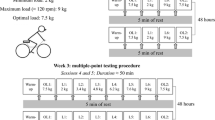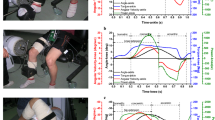Summary
The purpose of this investigation was to examine times to exhaustion at various percentages of the electromyographic fatigue threshold (EMGFT). Eight adult males [mean (SD), 21 (1) years] volunteered for the investigation. EMGFT was derived by determining the rate of rise in the electrical activity of the vastus lateralis [using integrated electromyography (iEMG)] over time (iEMG slope) for four fatiguing power outputs during cycle ergometry. The four power outputs were then plotted as a function of the four iEMG slope coefficients. The y-intercept of the power output versus iEMG slope coefficient graph was defined as the EMGFT. The intraclass correlation for repeated EMGFT tests was R=0.65 (SEE=7 W) and there was no significant (P>0.05) difference between the mean (SD) values for test [260 (11) W] versus retest [262 (32) W]. Actual times to exhaustion were determined for work bouts at power outputs equal to 85, 100, 115, 130, and 145% of EMGFT. The mean (SD) times to exhaustion for these work bouts were 495 (231), 225 (72), 135 (35), 94 (17), and 72 (14) s, respectively. A power curve was derived using the mean power outputs and mean times to exhaustion from the five rides at various percentages of EMGFT. The power curve provided estimates of the power outputs which could be maintained for 30 and 60 min. There were significant (P<0.05) differences between the mean EMGFT (260 W) and the power outputs which could be maintained for 30 (151 W) and 60 (125 W) min. EMGFT overpredicted the estimated power outputs that could be maintained for 30 and 60 min by 42% and 52%, respectively.
Similar content being viewed by others
References
deVries HA (1968) Method for evaluation of muscle fatigue and endurance from electromyography fatigue curves. Am J Phys Med 47:125–135
deVries HA, Moritani T, Nagata A, Magnussen K (1982) The relation between critical power and neuromuscular fatigue as estimated from electromyographic data. Ergonomics 25:783–791
deVries HA, Tichy MW, Housh TJ, Smyth KID, Tichy AM, Housh DJ (1987) A method for estimating physical working capacity at the fatigue threshold (PWCFT). Ergonomics 30:1195–1204
deVries HA, Housh TJ, Johnson GO, Evans SA, Tharp GD, Housh DJ, Hughes RA (1990) Factors affecting the estimation of physical working capacity at the fatigue threshold. Ergonomics 33:25–33
Edwards RG, Lippold OCJ (1956) The relation between the force and the integrated electrical activity in fatigued muscles. J Physiol (Lond) 132:677–681
Housh TJ, deVries HA, Johnson G, Evans S (1991) An evaluation of the physical working capacity at the fatigue threshold test. Med Sci Sports Exerc 23: S94
Knowlton GC, Bennett RL, McClure R (1951) Electromyography of fatigue. Arch Phys Med 32:648–652
Leger L, Thivierge M (1988) Heart rate monitors: validity, stability, and functionality. Phys Sportsmed 16:143–151
Lippold OCJ, Redfearn JWT, Vuco J (1960) The electromyography of fatigue. Ergonomics 3:121–131
Matsumoto T, Ito K, Moritani T (1991) The relationship between anaerobic threshold and electromyographic fatigue threshold in college women. Eur J Appl Physiol 63:1–5
Missiuro W, Kirschner H, Kozlowski S (1962) Electromyographic manifestations of fatigue during work of different intensity. Acta Physiol Pol 13:11–20
Petrofsky JS (1979) Frequency and amplitude analysis of the EMG during exercise on the bicycle ergometer. Eur J Appl Physiol 41:1–15
Scherrer J, Bourguinon A (1959) Changes in the electromyogram produced by fatigue in man. Am J Phys Med 38:148–158
Author information
Authors and Affiliations
Rights and permissions
About this article
Cite this article
Pavlat, D.J., Housh, T.J., Johnson, G.O. et al. An examination of the electromyographic fatigue threshold test. Eur J Appl Physiol 67, 305–308 (1993). https://doi.org/10.1007/BF00357627
Accepted:
Issue Date:
DOI: https://doi.org/10.1007/BF00357627




